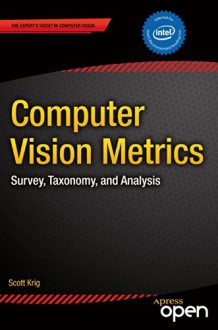Computer VisionMetrics provides an extensive survey and analysis of over 100 current andhistorical feature description and machine vision methods, with a detailed taxonomyfor local, regional and global features. This book provides necessarybackground to develop intuition about why interest point detectors and featuredescriptors actually work, how they are designed, with observations abouttuning the methods for achieving robustness and invariance targets for specificapplications. The survey is broader than it is deep, with over 540 referencesprovided to dig deeper. The taxonomy includes search methods, spectracomponents, descriptor representation, shape, distance functions, accuracy, efficiency,robustness and invariance attributes, and more. Rather than providing ‘how-to’ sourcecode examples and shortcuts, this book provides a counterpoint discussion tothe many fine opencv community source code resources available for hands-onpractitioners.What youll learnInterestpoint & descriptor concepts (interest points, corners, ridges, blobs,contours, edges, maxima), interest point tuning and culling, interest point methods(Laplacian, LOG, Moravic, Harris, Harris-Stephens, Shi-Tomasi, Hessian, differenceof Gaussians, salient regions, MSER, SUSAN, FAST, FASTER, AGHAST, local curvature,morphological regions, and more), descriptor concepts (shape, sampling pattern,spectra, gradients, binary patterns, basis features), feature descriptorfamilies.Localbinary descriptors (LBP, LTP, FREAK, ORB, BRISK, BRIEF, CENSUS, and more).Gradientdescriptors (SIFT, SIFT-PCA, SIFT-SIFER, SIFT-GLOH, Root SIFT, CensureE,STAR, HOG, PHOG, DAISY, O-DAISY, CARD, RFM, RIFF-CHOG, LGP, and more).Shape descriptors(Image moments, area, perimeter, centroid, D-NETS, chain codes, Fourier descriptors,wavelets, and more) texture descriptors, structural and statistical (Harallick,SDM, extended SDM, edge metrics, Laws metrics, RILBP, and more).3Ddescriptors for depth-based, volumetric, and activity recognition spatio-temporaldata sets (3D HOG, HON 4D, 3D SIFT, LBP-TOP, VLBP, and more).Basisspace descriptors (Zernike moments, KL, SLANT, steerable filter basis sets,sparse coding, codebooks, descriptor vocabularies, and more), HAAR methods(SURF, USURF, MUSURF, GSURF, Viola Jones, and more), descriptor-based imagereconstruction.Distancefunctions (Euclidean, SAD, SSD, correlation, Hellinger, Manhattan, Chebyshev,EMD, Wasserstein, Mahalanobis, Bray-Curtis, Canberra, L0, Hamming, Jaccard),coordinate spaces, robustness and invariance criteria.Image formation,includes CCD and CMOS sensors for 2D and 3D imaging, sensor processing topics, witha survey identifying over fourteen (14) 3D depth sensing methods, with emphasison stereo, MVS, and structured light.Image pre-processingmethods, examples are provided targeting specific feature descriptor families(point, line and area methods, basis space methods), colorimetry (CIE, HSV,RGB, CAM02, gamut mapping, and more).Groundtruth data, some best-practices and examples are provided, with a survey ofreal and synthetic datasets.Visionpipeline optimizations, mapping algorithms to compute resources (CPU, GPU,DSP, and more), hypothetical high-level vision pipeline examples (facerecognition, object recognition, image classification, augmented reality),optimization alternatives with consideration for performance and power to make effectiveuse of SIMD, VLIW, kernels, threads, parallel languages, memory, and more.Syntheticinterest point alphabet analysis against 10 common opencv detectors todevelop intuition about how different classes of detectors
show less

